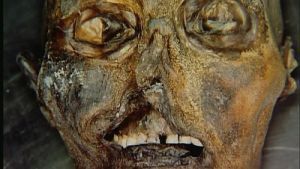Horizon
Death of the Iceman (2002x5)
:
In September 1991 two hikers made a sensational discovery - a frozen body high in the mountains, near the border between Austria and Italy. It turned out to be 5,300 years old, the oldest frozen mummy ever found. Named Ötzi the Iceman after the Ötztal area where he was found, he became a worldwide sensation.
The body was taken to Austria where scientists soon got to work on him. They analysed his bone density to find out how old he was (in his 40s, an advanced age for the time) and examined his wonderfully preserved belongings. The cause of his death remained a mystery. Now archaeologists are being joined by forensic scientists to investigate this unique case and new research has revealed a shocking answer.
The investigation into Ötzi's death started at the scene of discovery. By examining photos which had been taken at the site, Austrian archaeologist Konrad Spindler worked out the layout. He was particularly intrigued by the position of the Iceman's copper axe, which was found propped up against a rock. He believed that this must have been placed in that position by Ötzi himself which meant that everything at the site had been preserved in the position it was when Ötzi died. His body was slumped face down on the ground, his cap lay nearby just as if it had fallen from his head.
Scientists also wanted to know when he died so they examined the ice in which he'd been found. This contained pollen that they could identify as coming from autumn-flowering plants, so they concluded that Ötzi had died in the autumn. Together, this evidence implied that the Iceman might have got caught in a storm and died of hypothermia.
Then the scientists looked inside the iceman using X-rays and CAT (Computer Assisted Tomography) scans. They saw what looked like unhealed rib fractures. So Spindler came up with what he called his disaster theory. He believed Ötzi was a shepherd who, one autumn, was returning to his home village with his animals. When he got there he be
